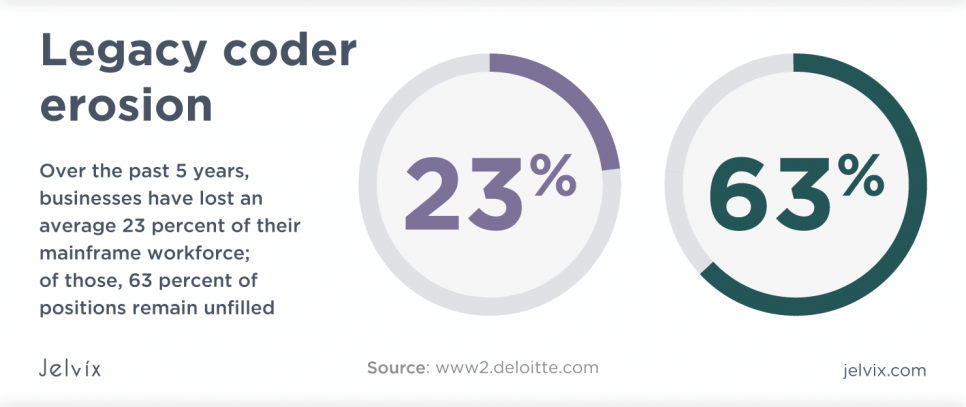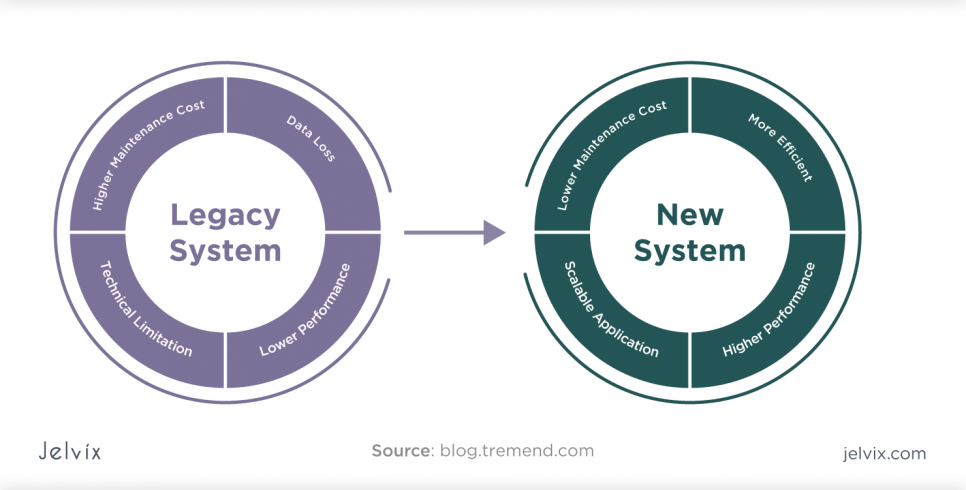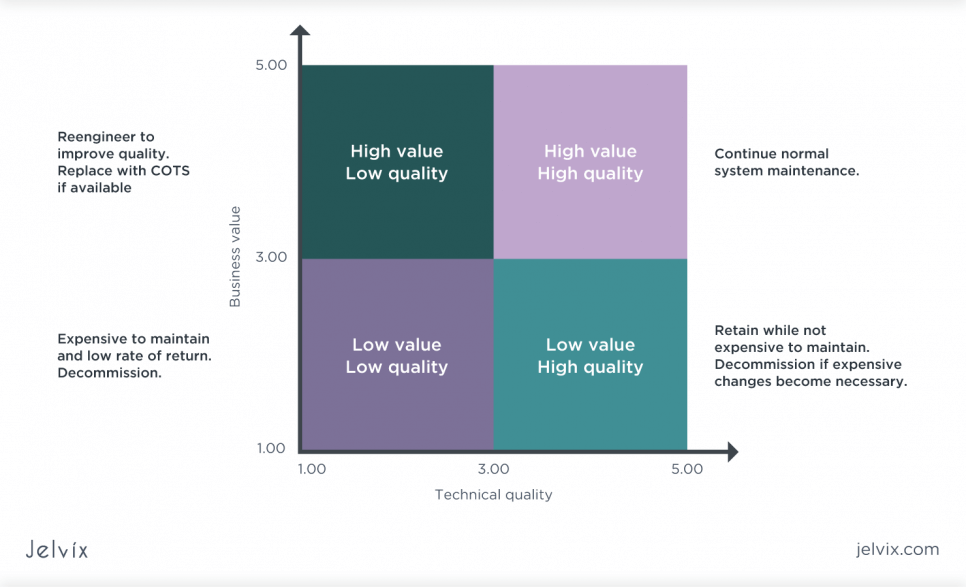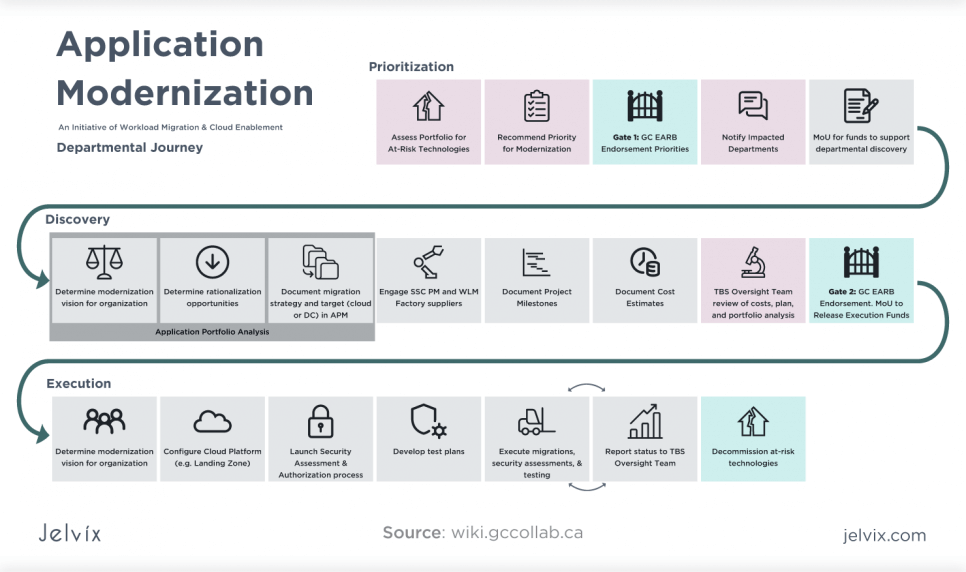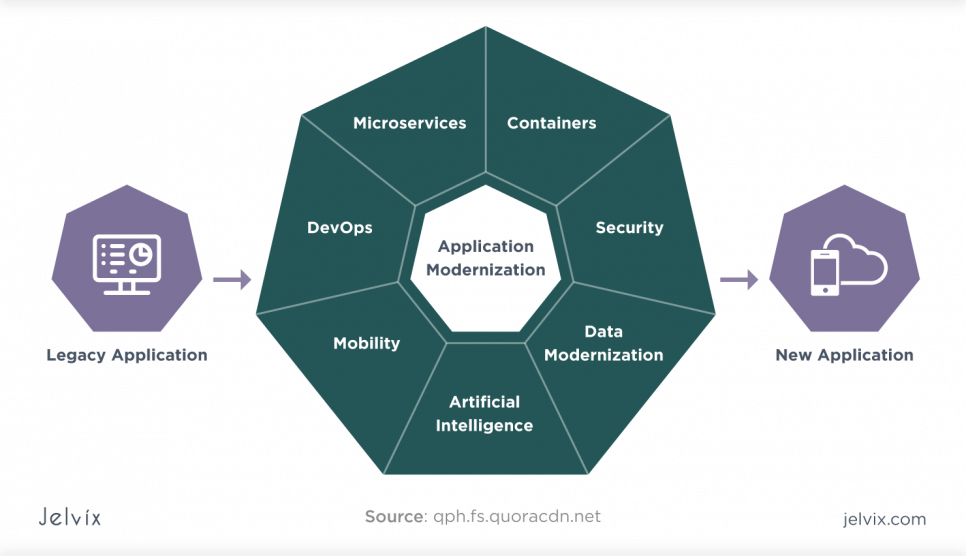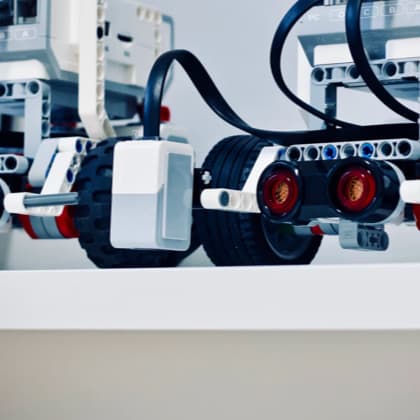Most technology products have a life cycle of only five years, Flexera says. Then outdated technologies become a severe IT issue that almost all organizations face eventually. Antiquated IT systems generate bugs, errors, and critical issues with a domino effect that must be eliminated.
With companies spending 60-80% of their IT budget supporting legacy systems and applications, 44% of CIOs rightly believe that complex legacy software is slowing business digital transformation.
Gartner says that for every dollar spent on digital innovation, three dollars are spent on upgrading applications. And this disproportionate amount of money wasted on keeping legacy systems afloat could be an investment in further development. Therefore, many companies are looking for ways to reduce the dependency on legacy technologies and move forward into the future.
What Is Application Modernization?
All platforms and programs that your business uses daily are constantly being improved. Accordingly, a company’s digital infrastructure is focusing on more competent tools that better match its needs and the capabilities of the IT landscape.
Legacy application modernization aligns the existing legacy software stack with modern business and functional requirements using new technologies.
The overriding goal of upgrading legacy systems is to guarantee that the upgraded system has the same capabilities and is compatible with existing data formats.
It is an incremental process different for each organization and may include adopting technologies such as the cloud, mobility, advanced analytics, and cybersecurity. By modernizing the legacy technology, some companies have achieved productivity gains of 40% and revenue growth of 14%.
What is the Legacy Application?
Systems that are often thought of as “old” are software stacks that fit in the 2000s, not 2023, and are written in languages like COBOL or Fortran.
But neither programming language nor age determines whether a system is outdated. It can be any software, technology, or system that blocks or slows down business processes, making it difficult to adapt to market dynamics.
Some apps are a priori difficult to modernize. Take applications like SAP, Oracle, or PeopleSoft, for example. These solutions are monolithic and cannot update particular aspects individually. As a result, the system meets the initially created needs but does not interact well with newer solutions or allow for growth.
There are fewer and fewer professionals who can work with outdated software every year. In many cases, legacy software requires dedicated legacy hardware infrastructure, which only exacerbates the problem.
Another case is when the original developers are gone, and there is little documentation left about the system. Defining the scope of requirements for a new system or migrating data from a legacy system can overwhelm any company.
What is legacy software, for example? Take the IRS computer system, the code for which was written in assembly 60 years ago. This old system somehow continues to maintain nearly 1 billion records.
Banks, airlines, retailers – almost every major industry deals with old IT hardware and legacy code. These older systems are more error-prone and troubleshooting is difficult and costly as most were written in COBOL, the programming language of the 60s and 70s.
Now, 30 lines of Java code can perform the same operations as 600 lines of COBOL code. The Financial Times informs that a lack of developers for COBOL, which most banking mainframes are based on, will eventually force banks to move to the new platform.
In retail, corporations spend 58% of their IT resources on maintaining legacy systems. Regardless, 69% of companies are reluctant to innovate because they are not sure if it will solve cybersecurity problems. But in fact, the opposite is true. Legacy systems are insecure due to the extensive customer data available in the interface.
Younger systems also fall into this category, such as systems built-in Python 2, which does not have an active developer community, or Elm, which no one wants to work with.
Legacy Systems and Technologies Problems
Legacy apps are incompatible with today’s new and growing technologies such as cloud computing, mobility, the latest cybersecurity, and API use. Critical disadvantages include disproportionately high maintenance costs, disparate data that impede integration between systems, and data protection issues.
Moreover, legacy software has a massive codebase. Therefore, updating one area can affect others, causing unexpected problems. This is why changes to the codebase of legacy software should be made with extreme caution and after extensive testing.
Sometimes organizations need quick and complete access to records that are 10-15 years old. Unavailable data in formats that do not allow reliable queries can cause lost revenue or even penalties for non-compliance with data storage requirements. Ultimately, all these factors call into question the continued use of outdated systems.
However, Gartner warns that ditching legacy systems such as IBM mainframes can affect their quality and be too expensive. Surprisingly, Standish Group research confirmed that nearly half of all modernization attempts by rewriting mainframe or IBM applications have failed due to a lack of funding.
Another 47% of rewritten projects experienced cost overruns because of a lack of automation. Only 4% of such app rewriting attempts were successful. Legacy systems are too complex to be easily transferable to new technologies.
Why are Modernizing Legacy Applications so Crucial?
Business leaders looking to drive innovation across their companies need new technologies to stimulate and sustain them in the actual world. There are fast applications, flexible open systems, and platforms that bring it all together. Unfortunately, older IT stacks no longer meet these requirements.
Therefore migrating legacy applications to modern infrastructures such as the cloud and containers offers great promise for enterprises looking to reduce IT costs and gain a competitive advantage through innovation.
If a company does not update its software promptly, it loses more in the long term because of the loss of competitive advantage and access to innovative technologies. Moreover, the longer the delay, the more expensive the upgrade will cost. After three years of waiting, the costs of replacing or upgrading systems are increasing exponentially.
“With every new feature that you are adding to the existing system, you are making migrating off that system harder”. David Knott, HSBC Chief Architect
Prerequisites for Software Modernization
Why is now the right moment to update legacy software?
- During COVID-19, many operations have gone digital, and businesses need to expand their online presence.
- Lots of legacy systems are standalone and do not support integration with the latest software. This can affect the flexibility and scalability of the entire organization.
- The omnichannel business model requires companies to be adaptable and responsive to the needs of emerging markets and the availability of products across multiple channels.
- Outdated systems exacerbate security risks because some of them do not receive updates or fixes.
Upgrades are necessary if your company software runs in Delphi or Borland C++; you cannot access the software from mobile devices; you need to maintain an expensive larger server, and so on.
Organizations do not modernize applications for many reasons, but the most common are cost savings, a lack of skills, and a deficit of solutions that meet all the organization’s needs. Consequently, companies are only monitoring the industry with no actions.
This makes sense when your current tech stack is relatively up-to-date and coping well with the required load levels. But retention is a temporary measure, not a long-term strategy. Technologies are advancing so rapidly that change is inevitable, and you still have to upgrade your software to keep it stable.
Profits of Legacy Application Modernization
IDC says that by 2026, 75% of market leaders will have systemic digital innovation programs and investments to support iterative innovation, enabling growth, scale, agility, and resilience. This claim is supported by the forecast that by 2026, global digital transformation spending is projected to reach 3.4 trillion U.S. dollars.
According to the IDG and Insight Report on the status of IT modernization in 2020, 26% of organizations started an IT modernization process, and 19% were making moderate progress. Modern companies that have adopted new technologies and methodologies, such as Agile, report a 30-50% increase in throughput over their older counterparts.
This is driven by critical factors such as migrating workloads to the cloud and SaaS services, increased focus on digital transformation, and the need for a more resilient modern infrastructure. It also means that companies around the world have already recognized the need for change.
Modernizing legacy applications can save 35% of the infrastructure budget on an annualized basis and reduce the cost of maintaining and operating applications by 30-50%.
Besides, the result of software modernization will be:
- Incorporating business intelligence into the core systems
- Solving mobility problems
- Reducing processing time
- Fast analyzing and prevention of fraud
- Supporting regulations and compliance requirements
- Increasing customer satisfaction
- Providing new technology and business channels
How to Prepare for Upgrading Legacy Systems
By thinking about how to migrate data from legacy applications, organizations can manage the lifecycle of their applications and retain important data even after the legacy application is closed.
Determine the goals of modernization
Depending on your goals, industry, and market, you must predict how upgrading an outdated system will affect your company’s revenue, customer experience, market share, and more. The perceived cost and high risks may force an organization to make short-sighted decisions.
Assess the current state of the system and application portfolio
The next step is to examine how the current system works. Review your app’s portfolio: evaluate your current legacy environment, interdependencies, application usage, data types, and determine how they align with your business goals.
This will help outline a primary roadmap for upgrades and prioritize applications to upgrade. At the current pace of technological innovation, there are always areas that can be adapted and improved.
Choose a modernization strategy
Choosing the correct type of upgrade for your legacy software can be a daunting task. So it is so helpful to know more about the options available – it will make it easier to interact with software vendors. If you partner with a software development company, they will expertly evaluate your system and suggest the most appropriate approach.
Learn more about the main stages of product development lifecycle to build a sustainable product.
Seven Legacy Systems Upgrade Options Based on Risk
Legacy application modernization is a goal that you can reach by taking different roads, and there is no one-size-fits-all way to make this journey. It doesn’t matter which upgrade option you end up using.
Anything is better than waiting for your more advanced competitors to push you out of the market. There are several strategies for upgrading legacy systems. The list is formed in order of increasing complexity and cost.
Low-Risk Processes: Localized Changes and Improvements to the Existing System
- Encapsulating
Companies that cannot rely on over-extended complex legacy applications are looking for ways to move forward without disrupting long-standing business processes. This method allows them to use and extend the application’s capabilities by encapsulating its data and functions, making them available as services through the API.
This way, they can improve the system’s security, make it easier to interact in real-time, and more.
Despite its high availability and low risk, this method does not address the underlying problems of legacy applications, such as difficulties with maintenance and updates. This process is only about the interface.
- Rehosting
This method allows you to redeploy an application component to a different infrastructure (physical, virtual, or cloud) without changing its code, features, or functionality.
For example, it might make sense to move your legacy system to an SQL-based environment or the cloud. Re-hosting is the most affordable way to fix the problem, but you can only apply it to agile legacy solutions.
Moving to x86 systems based on SQL results in lower acquisition costs and less stringent cooling and space requirements.
According to Gartner analysts, more than 85% of organizations will follow a cloud-first principle by 2025. They will only be able to execute their digital strategies using cloud-native architectures and technologies. Legacy systems migration to the cloud makes them more flexible than on-premises hardware and improves the security, stability, and continuity of data updates.
A relocation strategy is less expensive and less risky and is faster than re-engineering (which can take years to complete). Simultaneously, the business logic remains unchanged, so the system works the same as before.
- Replatforming
This method involves porting business apps to a completely different computing platform (physical, virtual, or cloud) to improve the scalability, reliability, security, and cost of the computational economic model without modifying its code, features, or functions.
Developers leave the software as it is, keeping its functionality but adapting it to another platform. This allows you to reuse resources that developers are used to working with, such as development environments or legacy programming languages. In addition, migration can be part of an upgrade project if necessary to achieve the desired system capabilities, such as flexibility and scalability.
Medium Risk Processes: Gradual Replacement or Refurbishment
- Refactoring
This approach allows you to restructure and streamline the existing code on the back end without changing the behavior or functionality of the front end. Refactoring is carried out to get rid of technical problems and improve the component’s functions and structure. In addition to re-coding portions of the existing system, organizations gain cloud capabilities, allowing for greater economies of scale while increasing business revenues.
- Rearchitecting
The redesign means a complete change of the application code to move it into the new application architecture. By changing the code, you can take full advantage of the latest and better features of the existing platform.
For example, you can achieve this by ditching the old monolithic architecture and moving to modern microservices. According to Forbes, by 2022, 90% of all new applications will contain a microservice architecture. They are in demand because they improve the ability to debug, update, design, and use third-party code.
With microservices, you can break up a vast legacy application into blocks. You can then rebuild one functional block using modern technology and deploy it as a standalone app. Another advantage is to leave the code in its current environment by connecting it to additional access levels through the API.
Remember that there is no eternal technology, and each system has its expiration date. Refactoring, re-architecture, or minor system improvements can keep you afloat for a few more years. So keep developing a strategy for further improvements.
High-Risk Processes: Complete Transformation or Replacement
Complete conversion of legacy systems is risky and complex, as proven by a 74% failure rate. However, a complete overhaul of legacy systems is necessary if:
- Your software is written in a legacy programming language (such as Fortran or COBOL).
- Critical elements of your kernel are approaching EOS and are not supported by the vendor.
- You cannot implement mission-critical technologies that support innovative digital offerings and customer solutions.
- Over 80% of your IT budget is spent on service and support.
- You’ve already tried less risky strategies, but you still haven’t achieved your goals.
You can do the complete conversion in two ways:
- Replacing
This way means switching to another packaged solution that suits your business needs. Sometimes it is more efficient to switch to an original system than to upgrade an existing one. However, if replaced, you cannot reuse current business logic. Some level of re-engineering, customization and rewriting of business logic will be required.
Customizing a package can be tricky – and risky. However, this method is appropriate when an outdated system cannot be used due to a lack of specialists or equipment.
- Rebuilding (Rewriting)
This method means creating a new system from scratch but with the same functionality. Such type of system upgrade is practiced when the cost of maintaining a legacy system is higher than the cost of rebuilding it, and clients want more than the current system can provide.
Let us say, you take a monolithic application and replicate its functionality as a microservice running in a cloud environment. The method requires careful analysis of interconnected components, systems, and applications because you cannot upgrade one legacy system component while ignoring all others.
However, in the case of extremely outdated technologies, you simply have to shut down the old system to avoid downtime, security breaches, or data loss.
Concluding Thoughts
Legacy modernization is an inevitable stage in digital transformation, driven by innovations such as artificial intelligence, virtual/augmented reality, and the Internet of Things. From 2018 to 2023, 500 million new logic apps are estimated to appear with new tools/frameworks, agile methods, and a lot of code reuse, and they will gradually supplant old systems.
However, being the primary way to make progress, software modernization comes at a cost. In the IT world, it includes the expenses for upgrading or replacing outdated systems, which could add up to a significant amount of money. However, it is an investment to grow your business.
Want to learn more about how to modernize your application or environment? Planning to do an app inventory or appraisal and gradually transform your business?
The Jelvix has extensive experience in updating legacy applications, building solutions for existing platforms, and working with clients in complex environments. Our dedicated development team will assess your application portfolio and tailor a method or a hybrid combination based on short and long-term value for your business. Contact us right now!
Need a certain developer?
Use our talent pool to fill the expertise gap in your software development.




